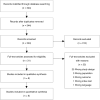Predictive value of computed tomography for short-term mortality in patients with acute respiratory distress syndrome: a systematic review
- PMID: 35689019
- PMCID: PMC9185136
- DOI: 10.1038/s41598-022-13972-x
Predictive value of computed tomography for short-term mortality in patients with acute respiratory distress syndrome: a systematic review
Abstract
The best available evidence and the predictive value of computed tomography (CT) findings for prognosis in patients with acute respiratory distress syndrome (ARDS) are unknown. We systematically searched three electronic databases (MEDLINE, CENTRAL, and ClinicalTrials.gov). A total of 410 patients from six observational studies were included in this systematic review. Of these, 143 patients (34.9%) died due to ARDS in short-term. As for CT grade, the CTs used ranged from 4- to 320-row. The index test included diffuse attenuations in one study, affected lung in one study, well-aerated lung region/predicted total lung capacity in one study, CT score in one study and high-resolution CT score in two studies. Considering the CT findings, pooled sensitivity, specificity, positive likelihood ratio, negative likelihood ratio, and diagnostic odds ratio were 62% (95% confidence interval [CI] 30-88%), 76% (95% CI 57-89%), 2.58 (95% CI 2.05-2.73), 0.50 (95% CI 0.21-0.79), and 5.16 (95% CI 2.59-3.46), respectively. This systematic review revealed that there were major differences in the definitions of CT findings, and that the integration of CT findings might not be adequate for predicting short-term mortality in ARDS. Standardisation of CT findings and accumulation of further studies by CT with unified standards are warranted.
© 2022. The Author(s).
Conflict of interest statement
The authors declare no competing interests.
Figures




References
-
- Ranieri VM, et al. Acute respiratory distress syndrome: The Berlin definition. JAMA. 2012;307:2526–2533. - PubMed
Publication types
MeSH terms
LinkOut - more resources
Full Text Sources
Research Materials

